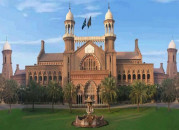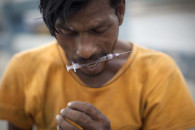Ashura: ‘Making installations is my way of paying respect’
Artisans take from one week to a year to prepare models.

Ashura: ‘Making installations is my way of paying respect’
The first week of Muharram is among the busiest days of the year for Mukhtar Ahmad. A Sunni himself, Ahmad makes installations associated with mourning (ta’azia) ordered by Shias.
In a shop on Fleming Road, Ahmad manufactures installations of the alam of Ghazi Abbas (RA), zari (a installation of Hazrat Imam Hussain’s (RA) tomb), Hazrat Ali Asghar’s (RA) cradle, Shahzada Qasim’s (RA) mehndi and plaques bearing calligraphy. “I have been in the field for around 20 years.
I make the installations as a way of expressing my reverence,” he says.
Zaris are usually made of wood while alams from steel or iron. Cradles are made from both materials.
Ahmad says he learnt the art from an ustad who hailed from Srinagar.
There are several other artisans on Fleming Road. 65-year-old Muhammad Yaqoob is one of them and has been practicing the art for 36 years. “A person can get the basic know-how in two or three years but it can take up to 10 years to become really skilled,” he says.
Yaqoob said he learnt the art from Srinagar and Muradabad in India. His three sons are also in the same field.
“There are three stages involved in the manufacturing of an installation,” he says, “chitai, banai and polai”. The first step is to make a paper sketch of the tomb or alam – whatever a customer provides them a picture of. Next, a frame is developed and then the work of decorating it begins. Polishing comes at the end.
Yaqoob claims to be an expert in several styles of metal craft including Delhi Art, Iranian Art, Egyptian Art and Kashmiri Art to name a few. He says that the Iranian style is the most popular these days, followed by Kashmiri artwork.
Muhammad Nasir, another artisan who manufactures installations, says that a medium sized zari takes around a month to complete. “A really big one can take up to a year,” Nasir says.
His brother has gone to the US to a fix a zari and claims to have clients in Canada, Dubai, Afghanistan and England. “We are at work throughout the year,” he says.
Ta’azia installations and what they represent
Allama Abbas Sherazi, a Shia scholar spoke to The Express Tribune about the significance of various symbols said, “Each one has its own importance.” He said that the alam (flag), an important part of the Ashura procession, is associated with Abbas Ibn-i-Ali (RA). Also known as Ghazi Abbas (RA), carried the flag of Imam Hussain’s (RA) brief battalion of 72 people at the battle of Karbala. He was Imam Hussian’s (RA) half brother. The alam is carried in the mourning processions, he said, to honour Ghazi Alamdar’s (RA) loyalty.
Dilawar Hussain, a Shia devotee, said that alams were also hoisted on rooftops to get protection from misery and to commemorate the bravery of Hazrat Abbas (RA). “We wear karas (bracelets) to remember the misery of Hazrat Imam Zainul Abideen (RA), son of Hazrat Imam Hussain (RA), who was taken to Syria in handcuffs. Some devotees choose to chain themselves and walk barefoot in his memory.”
The cradle of Hazrat Ali Asghar (RA) is also carried in Ashura processions. Hazrat Asghar (RA) was the youngest martyr at Karbala. Only six months ols, he was martyred when his father pleaded with Yazid’s army to give him some water.
“His sister, Bibi Sakina (RA), used to rock an empty cradle afterwards, he said. Shias take a cradle out in the processions to pay homage to the bond between the siblings.
Sherazi said that Hazrat Qasim Ibn-i-Hassan (RA) was engaged to be married but joined the fighting against Yazid. He gave his life in the way of Allah and so we take out his mehndi to remind ourselves that everything else pales in comparison with a chance to sacrifice your life for Islam, he said.
(Read: Making symbols of reverence)
Published in The Express Tribune, December 6th, 2011.



















COMMENTS
Comments are moderated and generally will be posted if they are on-topic and not abusive.
For more information, please see our Comments FAQ